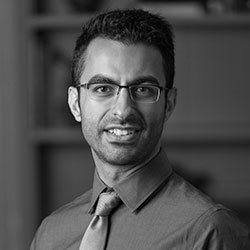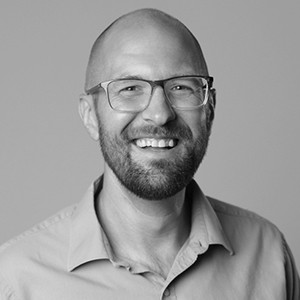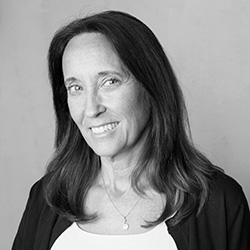Building a Better Future
As climate resilience program director for The Engineering Center Education Trust and the associate director of the 2022 American Institute of Architects National Board of Directors, Gail Kubik (B.Arch. ’10) is literally building a better future. Her deep commitment to social issues and her lifelong fascination with architecture has inspired her to pursue opportunities to address some of the biggest climate challenges the planet will face in coming years and figure out ways architects and engineers might rise to the challenge of climate change. She spoke to New York Tech News about her work and how she came to New York Tech.
Tell us a bit about yourself. How did you come to study architecture?
I was born and raised in Astoria, Queens, New York. My father was a New York City police officer, and my mother was a homemaker. My grandmother also lived in the same household, and I was fortunate to be raised in a multi-generational environment that instilled me with a sense of pride and care for my community. Although we lived humbly, my parents never missed an opportunity to expand my cultural awareness and take me to the many museums and sights New York has to offer. I have early childhood memories of my father and I spending time together drawing pictures of our street and of the houses on it. Through those moments, he taught me how to think about the spatial relationships of each building and how they interact with their surrounding environment. By the time I was eight years old, I was regularly envisioning places that didn’t exist and was hand drawing floor plans for buildings I thought people would enjoy. It was also at this time that my parents taught me about their understanding of the architectural profession, and from that moment forward, “architect” was my answer to the question, “What would you like to be when you grow up?”
Why did you choose New York Tech?
Before I went to architecture school, I attended Queensborough Community College, where I pursued an associate’s degree in architectural technology and learned the art of hand drafting and computer-aided design. Many of my professors were graduates of New York Tech and were architects. They encouraged me to continue my architectural studies at New York Tech, where I could pursue the accredited five-year Bachelor of Architecture degree.
I had already fulfilled many of my elective and foundation-level classes from my transferred credits, and this really opened up the full curriculum that New York Tech’s School of Architecture and Design offered. I was able to pursue multi-disciplinary courses in architectural history and theory, interior design, and even business to round out my education while taking the prescribed studio track.
Upon my graduation in 2010, I was able to navigate the recession that impacted our field by using the New York Tech alumni network to connect with other architects who were alumni. This was a valuable resource for me, and I was able to find a job opportunity where the principal architect of the firm was also a New York Tech graduate.
How did your studies prepare you to face the challenges of your job or position?
I gained an acute awareness of how an architect can be involved in more aspects of the built environment beyond the notion of designing or renovating buildings. Material research, energy/carbon analysis, disaster assistance, and policy formation are just a few examples of how architects can contribute to the conversations affecting the built environment.
Shortly after I graduated, Superstorm Sandy made landfall and devastated parts of New York and New Jersey. Although I only had a little over a year of professional work experience, I instantly felt the need to assist those affected. For the months after the storm, I volunteered to organize and lead teams of local architects and designers to conduct neighborhood and building damage surveys in the most affected communities across Queens and Brooklyn. By the spring of 2013, I was recruited by the non-profit organization Architecture for Humanity to be their disaster assistance fellow and assist with establishing their New York field office. Also, at that time, I co-created the Sandy Design Help Desk program, which provided vulnerable communities in New York and New Jersey with pro-bono design services to begin the rebuilding process. The program was awarded a Special Citation by AIA (American Institute of Architects) New York for “The Establishment of Long-Term Community-Based Planning Infrastructure Post Sandy.”
Can you tell us about your position as climate resilience program director with The Engineering Center Education Trust?
After I completed my requirements to pursue my architectural license, I wanted to utilize the knowledge and experiences I gained from working on Superstorm Sandy’s recovery and reconstruction to assist the architectural community in Boston to establish disaster resilience programs. Even though hurricane-type events are not common this far north, the architectural community in Boston was aware that if Superstorm Sandy shifted its trajectory by six hours, it would have been Boston’s communities that would have suffered its impacts.
Building on my multi-disciplinary skill sets, I approached AIA Massachusetts, the Structural Engineers Association of Massachusetts, and the Boston Society of Civil Engineers Section to pitch the creation of an alliance between the professions to establish a disaster assistance program to train design professionals to assist communities after a natural disaster. The leadership of The Engineering Center Education Trust, a local non-profit organization in Boston focused on promoting awareness of the engineering and design professions, approached me with an offer to become their climate resilience program director.
In this position, I have facilitated conversations, managed the partnership, and created the contractual documents to establish a state-wide disaster response program for the Commonwealth of Massachusetts. Known as the Architects and Engineers Emergency Response (AEER) Task Force, the program aims to promote awareness of the multiple types of hazards faced by communities throughout the state.
Congratulations on your appointment as the associate director of the 2022 AIA National Board of Directors. Can you tell us why you wanted to take on this role?
My journey to being the associate director of the 2022 AIA National Board of Directors stems from my desire to work within the profession to enact positive and long-standing change that enhances the value architects can provide to their communities. Prior to my appointment, I served as the associate representative of the 2021 AIA National Strategic Council, where I was involved in research aimed at identifying scalable climate action strategies the AIA could implement to complement their climate action plan. One of the strategies that stemmed from that effort was to establish a new educational program across the institute that focused on enhancing an architecture professional’s knowledge of carbon neutral design.
When I started my term on the AIA National Board of Directors, I advocated with AIA national leadership about the need to implement a carbon literacy education and certification program accessible to all 95,000 AIA members. This endeavor is earmarked to be the first certification program offered by the AIA. I hope to continue to collaborate with AIA staff in the coming year as the curriculum is prepared to launch in 2024/2025.
How do you think architecture has changed?
I have seen it change tremendously in the past 10 years in regard to climate resilient design. When I worked on Superstorm Sandy recovery and reconstruction, I created educational programs for architecture professionals on the basics of using resilient design. Since then, I’ve seen my educational programs evolve, first on applying an architect’s skills to assist communities with disaster assistance, then to architects providing technical assistance for climate action preparatory planning exercises. Now, with the creation of the carbon education and certification program, hopefully we’ll see architects step forward as leaders in net zero energy and carbon neutral conversations.
This interview has been edited and condensed.











